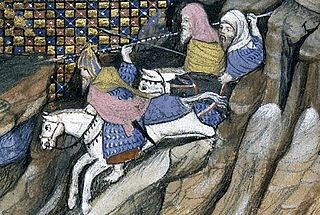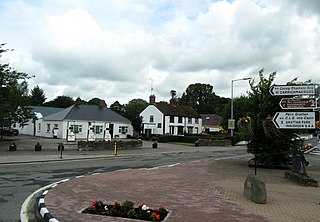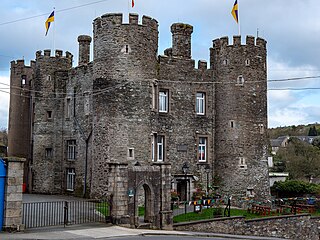This article needs additional citations for verification .(February 2024) |
| |||||
| Centuries: | |||||
|---|---|---|---|---|---|
| Decades: | |||||
| See also: | Other events of 1417 List of years in Ireland | ||||
Events from the year 1417 in Ireland.
This article needs additional citations for verification .(February 2024) |
| |||||
| Centuries: | |||||
|---|---|---|---|---|---|
| Decades: | |||||
| See also: | Other events of 1417 List of years in Ireland | ||||
Events from the year 1417 in Ireland.
Year 1417 (MCDXVII) was a common year starting on Friday of the Julian calendar.

Patrick Kavanagh was an Irish poet and novelist. His best-known works include the novel Tarry Flynn, and the poems "On Raglan Road" and "The Great Hunger". He is known for his accounts of Irish life through reference to the everyday and commonplace.
Diarmait Mac Murchada, was King of Leinster in Ireland from 1127 to 1171. In 1167, he was deposed by the High King of Ireland, Ruaidrí Ua Conchobair. To recover his kingdom, Mac Murchada solicited help from King Henry II of England. His issue unresolved, he gained the military support of the Richard de Clare, 2nd Earl of Pembroke, thus initiating the Anglo-Norman invasion of Ireland.

Art Óg Mac Murchadha Caomhánach was an Irish king who is generally regarded as the most formidable of the later kings of Leinster. He revived not only the royal family's prerogatives, but also their lands and power. During his 42-year reign, he dominated the Anglo-Norman settlers of Leinster. His dominance of the province and its inhabitants, both Gaelic and Hiberno-Norman, was deemed sufficiently detrimental to the colony that Richard II of England spent much of the years 1394 and 1395 sparring with him. While MacMurrough-Kavanagh did eventually submit to Richard, he renounced this fealty on Richard's departure and made much of his kingdom a death trap for any invading English or Anglo-Irish forces. The Crown accordingly dealt with him cautiously and he was granted an amnesty in 1409.

Richard Le Poer Trench, 2nd Earl of Clancarty, 1st Marquess of Heusden, styled The Honourable from 1797 to 1803 and then Viscount Dunlo to 1805, was an Anglo-Irish peer, a nobleman in the Dutch nobility, and a diplomat. He was an Irish, and later British, Member of Parliament and a supporter of Pitt. Additionally he was appointed Postmaster General of Ireland, and later, of the United Kingdom.

Arthur MacMurrough Kavanagh was an Irish politician. His middle name is spelled MacMorrough in some contemporaneous sources.
The Uí Ceinselaig, from the Old Irish "grandsons of Cennsalach", are an Irish dynasty of Leinster who trace their descent from Énnae Cennsalach, a supposed contemporary of Niall of the Nine Hostages. Énda was said to be a grandson of Bressal Bélach and a first cousin of Dúnlaing mac Énda Niada, eponymous ancestor of the rival Uí Dúnlainge.
Events from the year 1415 in Ireland.

Kavanagh or Kavanaugh is a surname of Irish origin, Caomhánach in Irish. It is one of the few Irish surnames that does not traditionally have an O or a Mac in either English or Irish.

Inniskeen, officially Inishkeen, is a small village, townland and parish in County Monaghan, Ireland, close to the County Louth and County Armagh borders. The village is located about 17 kilometres (11 mi) from Dundalk, 11 km (7 mi) from Carrickmacross, and 5 km (3 mi) from Crossmaglen. Seven townlands of this Roman Catholic Diocese of Clogher parish lie within County Louth.
Thomas Kavanagh, The MacMorrough was an Irish landowner.

Tinryland is a village in County Carlow, Ireland, less than 5 km south of Carlow town. It is within the townland of Tinriland, in the parish of Tullowmagimma.

Caomhánach is an Irish-language surname first assumed by Domhnall Caomhánach, eldest son of the 12th-century Diarmait Mac Murchada, king of Leinster. A considerable number of anglicised variations of Caomhánach exist; some of the most common are Kavanagh, Cavanagh, Kavanaugh and Cavanaugh.
Elizabeth le Veel, also known as Elizabeth Calf, was an Anglo-Irish noblewoman, and wife of Art mac Art MacMurrough-Kavanagh, King of Leinster. Her marriage to Art violated the Statutes of Kilkenny, and resulted in her property being forfeited to the English crown. This caused her husband to declare war in Ireland against the forces of King Richard II of England.
Cahir mac Art Kavanagh, "The MacMurrough" and King of Leinster, also Lord of St. Molyns, and baron of Ballyann, was an Irish magnate of the Tudor period.
Domhnall Spáinneach Mac Murchadha Caomhánach was the last King of Leinster.
Events from the year 1554 in Ireland.
Events from the year 1375 in Ireland.

Enniscorthy Castle is situated in Enniscorthy, County Wexford, Ireland. Construction on the castle commenced in the late 1190s and was first occupied by its Norman owners in 1203 A.D. on the site of a previous wooden castle they had erected some years earlier. It was built by Philip De Prendergast
Gerald Kavanagh, known as Gerald of Ferns, was King of Leinster from 1518 to 1522, when his son Morogh succeeded him. His father was Art Óg mac Murchadha Caomhánach, who was a king of Ireland and King of Leinster.